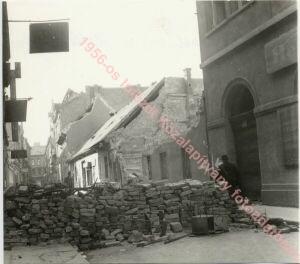
The Budapest ghetto was a ghetto where Jews were forced to live in Budapest, Hungary during the Second World War. The area consisted of several blocks of the old Jewish quarter of the city surrounding the main synagogue, and was surrounded by a high fence and stone wall that was guarded so that contraband could not be sneaked in, and people could not get out. The Nazi occupation of Budapest took place in March 1944. The ghetto was established in November, 1944, and lasted for less than three months, until the liberation of Pest on January 17, 1945 by the Soviet Army.
As with other ghettos that had been set up in other parts of Nazi-occupied Europe the area was completely cut off from the outside world: no food was allowed in, rubbish and waste were not collected, the dead lay on the streets and piled up in the bombed-out store fronts and the buildings were overcrowded, leading to the spread of diseases such as typhoid.
More than half of those that were forced into the ghetto in 1944 were sent to concentration camps, starting almost immediately from the establishment of the ghetto. From occupation to liberation the Jewish population of Budapest was reduced from 200,000 to 70,000 in the ghetto, and about 20,000 housed in specially marked houses outside the ghetto having been granted diplomatic protection by neutral politicians, including Raoul Wallenberg, who issued Protective Passports on behalf of the Swedish Legation, and Carl Lutz, who did the same via the Swiss Government. Of those that were deported (most of them to a concentration camp on the Austrian border), the vast majority were liberated by the advancing Red Army.
The last remaining section of the ghetto wall was demolished in 2006 during construction works. It was situated in the backyard of a building (No. 15 Király Street) and was originally an old stone wall made use by the Nazis in 1944 adding a line of barbed wire. The walls of the ghetto were typically older structures found on the area.
 Lefthit
Lefthit
3 comments:
I live in Atlanta, and our company has a bunch of people from Isreal who come here as contractors. My husband and I took one of them and her husband out to downtown once to take them to a club, while in the car we mentioned the "Ghetto" and which area's to avoid.. she said what do you mean the Ghetto? I sort of understood her confusion assuming they must have real Ghetto's in Isreal that arn't like the ones in America. Reading that makes me understand her confusion much more, and not ever want to use that word again.
I live in Budapest and frequently visit the former ghetto area. Although a lot of renovation has taken place in the past few years, the ghetto area still keeps some of its character, however is rapidly losing it due to the ongoing destruction of the old buildings, which are being replaced with modern apartment blocks. anybody visiting Budapest should go and look at this area before all signs of the old area have disappeared. In the meantime, to read some more details about the ghetto, please see http://www.budapestvacationservice.com/budapest_ghetto_1944-1945.html
is it possible to buy the photo of the ghetto in budapest?
Post a Comment